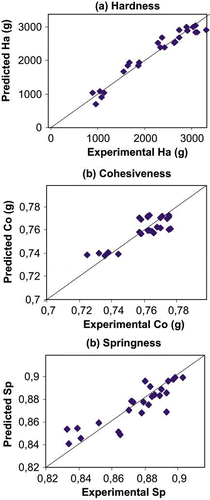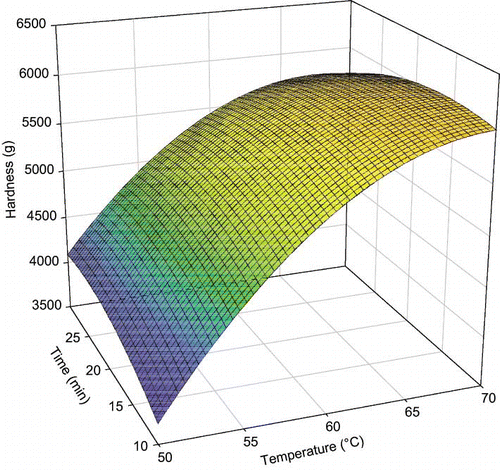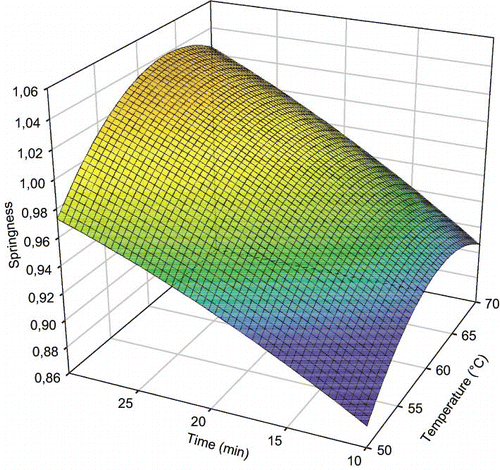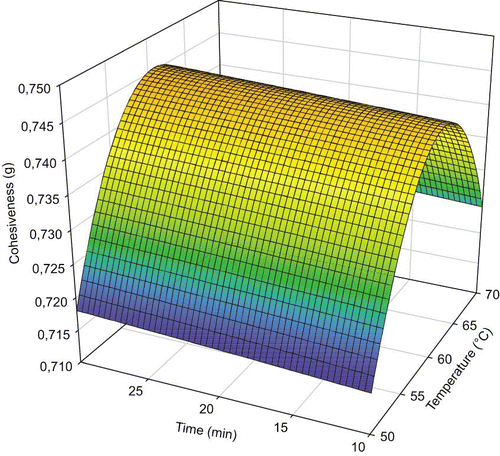Abstract
Texture properties are important indices for the evaluation of Bologna sausage quality. The objective of the study was to investigate the effect of cooking temperature and time on texture properties, to determine correlations between various texture properties (i.e., hardness, springiness, adhesiveness, cohesiveness, gumminess, chewiness, and resilience), and to develop kinetic models of selected texture properties as a function of cooking temperature and time. Cooking conditions were established at five levels of cooking temperature from 50–70°C, and at five levels of cooking time from 10 to 30 min. Results showed that cooking conditions (temperature and time) and their interactions significantly affected the texture properties except for the adhesiveness (p < 0.01). A significant correlation (p < 0.01) was found between gumminess and chewiness. The relationship between cooking temperature and time and texture properties can be well described by a second order polynomial equation. Statistical results showed that these kinetic models can be used (R2 > 0.92) for the prediction of Bologna sausage texture properties within the range of experimental cooking conditions.
INTRODUCTION
The manufacturing of bologna sausage consists of two major operations: 1) mixing with texturization in a mincer of pork and/or beef meat, pork fat, fat emulsions and connective tissue in water and salts; 2) cooking of the mixture into casings in a forced-convection air oven called smokehouse.[Citation1] The cooking unit operation is essential and important because it affects both the microbial safety and the final quality of products. During cooking, combinations of time and temperature have a strong influence on the tenderness as well as on other important quality factors such as the juiciness, the color, and the flavor.[Citation2] Changes in meat tenderness that occur during cooking are generally associated with heat-induced alterations of the components (collagen and myofibrillar proteins of the primary structure of the muscle tissue.[Citation3] The knowledge of the changes of texture properties during cooking is essential to establish a reasonable cooking process or to obtain a set of optimal processing conditions for specific products. There are numerous studies of texture properties of meat muscles reported in the literature. For example, Laakkonen et al.[Citation4] reported that meat tenderization and toughening during heating were due to the solubilization of the connective tissue and the denaturation of myofibrillar proteins, respectively. The relationship between toughness and cooking temperature was further studied by Davey and Gilbert.[Citation5] They reported that there were two stages for the toughness increase. The first increase was between 40 and 50°C due to the denaturation of the contractile system of muscle, while the second stage was between 65 and 75°C because of the collagen shrinkage. Similar results were found in other studies for the toughness increase.[Citation6,Citation7] Small differences were outlined depending on the temperature range.
More recently, kinetic models describing the change of toughness or hardness of meat muscles during heating were developed using a first order kinetic model.[Citation3] These were used to describe the phenomena occurring in the tendering and the toughening stage. Kinetic constants for both stages under different temperatures were obtained using a regression analysis, which was further used to calculate an activation energy (Ea) of 362.4 kJ/mol. These kinetic equations and related constant values were used by Califano et al.[Citation8] for the modeling of heat transfer and texture changes during the beef cooking process.
Several reports were published on the texture properties of meat products such as sausages and ham.[Citation9–12] However, most research focused on the effect of the chemical composition on texture properties under a certain set of processing conditions. A lack of information on kinetic parameters has been identified as a key factor to hinder further development in the area of computer simulations for the cooking process of specific meat and poultry products.[Citation13,Citation14] The objective of the study was to investigate the effects of cooking temperature and time on texture properties, to determine correlations between various texture properties (i.e., hardness, springiness, adhesiveness, cohesiveness, gumminess, chewiness, and resilience), and to develop prediction models of selected texture properties as a function of cooking temperature and time.
Materials and Methods
Source of Raw Materials
Uncooked raw emulsions of Bologna sausage were obtained from a local company and stored in the refrigerator at a temperature of 0–2°C prior to any experiment.
Cooking Process
The cooking process was carried out in a controlled temperature water bath. Using a syringe, sausage samples were inserted into copper cylinders of 12.7 cm in height and an internal diameter of 2.54 cm (maximum wall thickness of 0.159 cm). A rubber cover was placed at both ends of the cylinder to insulate them in order to keep the heat flow coming only from the radius of the cylinder. A thermocouple was installed at the core of the cylinder to measure the centre temperature. These cylinders were then placed in each temperature controlled water bath for cooking. The range and levels of cooking temperature and time are listed in . For each combination of conditions, three cylinder samples were used. It was noted that the cooking time listed in the table under the given cooking temperature did not include the come-up time of about 25 min which was determined by the preliminary experiments. After cooking, cylinders with the sausage samples were moved to another controlled temperature water bath and kept at 0°C for cooling down to a core temperature equal to about 20°C. The product samples was then stored in a refrigerator kept at 0–2°C.
Table 1 Range and levels of cooking temperature (T) and time (t)
Instrumental Texture Measurement
Texture properties were measured using a TA-XT2 Texture Analyzer. For all test samples, a double compression procedure (Texture Profile Analysis or TPA) was used at a speed of 0.8 mm/s. Measurements were performed at the room temperature (20°C). A core borer was used to cut samples of 15 mm in height and 25 mm in diameter. TPA parameters of hardness, cohesiveness, springiness, gumminess and chewiness were determined. Hardness was defined as the force required during the first compression. Springiness was the distance of the sample recovered in height after the first compression. Cohesiveness was calculated as the ratio of the two areas under the compression curves. Chewiness was the product of hardness, springiness and cohesiveness. Gumminess was the product of hardness and cohesiveness.[Citation15] Resilience is the property of a material that enables it to resume its original shape or position after being bent, stretched, or compressed also named as elasticity.
Data Analysis
Experimental data were statistically analyzed using MS Excel with the data analysis function. The statistical analysis included the correlation matrix of texture parameters, an analysis of variance with two factors (temperature and time), and a multiple non-linear regression analysis. The 3D visual prediction graphs were developed using the Sigmaplot software.
Choice of Kinetic Models
Generally, a first order kinetic model is used to describe the time dependency while an Arrhenius model is used to describe the temperature dependency. However, changes of texture properties during cooking is not simply increasing or decreasing linearly or semi-logarithmically with temperature and time as found from the preliminary experimental results and in other reports.[Citation3,Citation8] In this study, a second order surface response model was used for fitting the selected texture properties including hardness, cohesiveness, and springiness as a function of cooking temperature and time. Mathematically, the regression equation can be expressed as follows:
where Y can be one of the texture properties; a is constant value or the coefficient of the related item; and x1 and x2 are the cooking temperature (T) and time (t), respectively.
RESULTS AND DISCUSSION
Correlation and Variance Analysis
A correlation matrix was calculated using experimental results of texture parameters from the TPA. It is listed in . The negative sign of correlation coefficient values represented the negative relationship between the associated two parameters. The linear relationships between various texture parameters of cooked Bologna sausage can be easily analyzed. Hardness was highly related to the gumminess and the chewiness since their correlation coefficients were larger than 0.99. The correlation coefficients (0.999) for gumminess and chewiness also confirmed that they were highly dependent on each other. Another high relationship existed between the cohesiveness and the resilience with a value of 0.936. Adhesiveness was completely independent of other parameters with a very low associated correlation coefficient of 0.319. Springiness was also relatively independent of other parameters with the largest correlation coefficient value of 0.71 with the resilience. From that, parameters for representing the texture properties of the cooked Bologna sausage can be grouped in four categories: 1) hardness (ha) or gumminess (Gu) or chewiness (Ch); 2) cohesiveness (Co) or resilience (Re); 3) adhesiveness (Ad); and 4) springiness (Sp).
Table 2 Correlation matrix of texture parameters
An analysis of variance was performed for the effect of cooking temperature and time on texture properties and it is shown in . All texture properties were significantly affected by the temperature except for the adhesiveness. The cooking time affected significantly texture properties of Ha, Gu, Ch, and Sp but not Ad, Co, and Re. Interactions between cooking temperature and time were very significant on Ha, Gu, and Ch, and significant on Ad, Co, and Re, but not significant on Sp. It can be found that the adhesiveness was only affected by the interaction but not individual factors. Texture parameters of Hardness, Cohesiveness, and Springiness were selected for the following kinetic modeling analysis.
Table 3 ANOVA for effects of cooking temperature and time
Prediction Models of Selected Texture Properties
Using a multiple regression method, models for Ha, Co, and Sp were developed as:
The modeling performance of regression models was further evaluated by comparing predicted values to experimental data (). It can be found that all regression models can match very well experimental results within the experimental range of cooking temperature and time, confirming that the selection of a second order regression model was suitable to be used for the kinetic modeling of texture properties of Bologna sausage during cooking.
Typical Predictions by Regression Models
show the effect of both cooking temperature and time on three texture properties as predicted by various regression models. From , it can be seen that the cooking temperature had more effect on the hardness than the cooking time. The hardness increased with the cooking temperature within the range of 50–65°C. But after 65°C, the hardness reached a maximum value at a point called switch temperature and then went down slightly. The switch temperature for hardness was dependent on the cooking time. For example, when the cooking time was 10 min, the switch temperature was close to 70°C, while when the cooking time was 30 min, the switch temperature was around 66°C. It can also be found that the effect of cooking time on the hardness was related to the cooking temperature. The hardness increased with the cooking time when the cooking temperature was as low as 50°C, but it was decreased with the cooking time when the cooking temperature was as high as 70°C.
From , the effect of cooking conditions on the springiness can be easily deduced. First, the effect of the cooking time on the springiness was larger than the cooking temperature. Second, the springiness increased linearly with the cooking time under any cooking temperature. Third, the effect of the cooking temperature was dependent on the range of temperatures. When the cooking temperature was less than 65°C, the springiness increased. However, within the range of 65–75°C, the springiness was decreasing with an increasing cooking temperature. shows that the cohesiveness was only affected by the cooking temperature and the effect of the cooking time was not significant. When the cooking temperature was in the range of 50–65°C, the cohesiveness increased. But, it decreased within the range of 65–70°C.
CONCLUSION
Texture properties of cooked bologna sausages under different conditions were measured using a TA-XT2 Texture Analyzer. A correlation matrix for texture properties was developed and used for the selection of the main independent texture properties. An analysis of variance (ANOVA) was used to determine significant levels of cooking temperature and time on selected texture properties. Second order regression models were developed for the kinetic modeling of main texture properties (i.e., hardness, springiness, and cohesiveness) as a function of cooking temperature and cooking time. The model performance was confirmed by a statistical and a visual representation. Theoretical predictions were in good agreement with experimental results. Three regression models were further implemented for the analysis of the effect of cooking conditions on the hardness, springiness and cohesiveness. The importance of considering both factors at the same time in the development of the meat texture upon applying a cooking was highlighted. Information obtained from this study can be useful for the establishment of cooking cycles, and the optimization of the cooking process for bologna sausage or similar meat products particularly with respect to texture properties.
ACKNOWLEDGMENTS
The authors would like to thank Olymel-Flamingo for providing emulsions to perform these experiments and the Program on Energy Research and Development (PERD) from Natural Resources Canada, as well as the Canadian Agricultural Rural and Development (CARD), for providing the funding to perform this research. Finally, the authors would like to sincerely thank Olivier Gervais, a student in training in Chemical Engineering from Sherbrooke University, who devoted working hours to perform experiments.
References
- Zanoni , B. , Peri , C. , Pierucci , S. and Barattini , A. 1993 . Predictive modeling of bologna sausage cooking . Italian J. of Food Science , N4 : 311 – 322 .
- Martens , H. , Stabursvik , E. and Martens , M. 1982 . Texture and colour changes in meat during cooking related to thermal denaturation of muscle proteins . J. Text. Stud , 13 : 291 – 304 .
- Bertola , N.C. , Bevilacqua , A.E. and Zaritky , N.E. 1994 . Heat treatment effect on texture changes & thermal denaturation of proteins in beef muscle . J. Food Proc. Preserv. , 18 : 31 – 46 .
- Laakkonen , E. , Wellington , G.H. and Sherbon , J.W. 1970 . Low-temperature, logn time heating of bovine muscle. I. Changes in tenderness, water-binding capacity, Ph and amount of water soluble components . J. of Food Science , 35 : 175 – 177 .
- Davey , C.L. and Gilbert , K. 1974 . Temperature-dependent cooking toughness in beef . J. of Science Food Agric. , 25 : 931 – 938 .
- Bouton , P.E. , Harris , P.V. and Shorthose , W.R. 1974 . Changes in the mechanical properties of veal muscles produced by myofibrillar contraction state, cooking temperature and cooking time . J. of Food Science , 39 : 869 – 875 .
- Ledward , D.A. 1979 . “ Meat ” . In Effect of Heating on Foodstuffs , Edited by: Priestley , R. J. 157 – 193 . London : Applied Science Publishers .
- Califano , A.N. , Bertola , N.C. , Bevilacqua , A.E. and Zaritzky , N.E. 1997 . Effect of processing conditions on the hardness of cooked beef . J. of Food Eng. , 34 : 41 – 54 .
- Sofos , J.N. , Noda , I. and Allen , C.E. 1977 . Effects of soy proteins and their levels of incorporation on the properties of wiener-type products . J. of Food Science , 42 : 879 – 884 .
- Seman , D.L. , Olson , D.G. and Mandigo , R.W. 1980 . Effect of reduction and partial replacement of sodium on bologna characteristics and acceptability . J. of Food Science , 45 : 1116 – 1121 .
- Lin , G.C. , Mittal , G.S. and Barbut , S. 1990 . Effects of tumbling speed and cumulative revolutions on low sodium restructured hams . J. of Food Proc. Preserv. , 14 : 467 – 479 .
- Correia , L.R. , Mittal , G.S. , Usborne , W.R. and deMan , J.M. 1991 . Textureal parameters kinetics during smokehouse cooking of meat emulsions containing various fillers . J. of Food Eng , 13 : 27 – 56 .
- Chen , C.R. , Marcotte , M. and Ramaswamy , H.S. 2004 . A Computer Model To Establish Cooking Cycles for Meat Processing . 23rd Annual Conference of the Institute of Food Thermal Processing Specialists (IFTPS) . February 22–24 2004 . Kissimmee , FL
- Marcotte , M. , Chen , C.R. , Grabowski , S. , Ramaswamy , H.S. and Piette , G. 2008 . Modelling of Cooking-Cooling Processes for Meat and Poultry Products . International Journal of Food Science and Technology , 43 : 673 – 684 .
- Bourne , M.C. 1978 . Texture profile analysis . Food Technology , 32 ( 7 ) : 62 – 65 .



